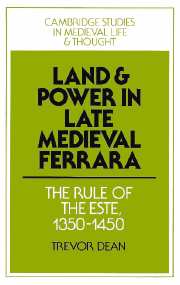Book contents
- Frontmatter
- Contents
- List of maps
- Preface
- List of abbreviations
- Note on sources
- Note on money, measurements and terms
- 1 Introduction
- 2 The Este patrimony
- 3 The Este vassals and their fiefs
- 4 Feudal tenure at Ferrara
- 5 Noble society at the centre
- 6 Noble society in the provinces
- Conclusion
- Appendices
- Bibliography
- Index
6 - Noble society in the provinces
Published online by Cambridge University Press: 10 November 2009
- Frontmatter
- Contents
- List of maps
- Preface
- List of abbreviations
- Note on sources
- Note on money, measurements and terms
- 1 Introduction
- 2 The Este patrimony
- 3 The Este vassals and their fiefs
- 4 Feudal tenure at Ferrara
- 5 Noble society at the centre
- 6 Noble society in the provinces
- Conclusion
- Appendices
- Bibliography
- Index
Summary
The construction of Este signorie in Modena, and later Reggio, posed quite different problems to those faced by the marquises in Ferrara. The political map, like the geographical, was very different. Unlike the flat Ferrarese, which was broken up, almost into an archipelago, by the Po delta and its valli, the contadi of Modena and Reggio were divided almost equally between hills and plain, with three smaller rivers running from south to north (the Enza, Secchia and Panaro). Large areas of these contadi in the later Middle Ages were held by territorial nobles whose landed bases formed rural lordships of a type not found in the Ferrarese: castles and jurisdictions, lands and powers of command. From such bases these families (again unlike the Ferraresi) often drew their name: thus the da Savignano, da Rodeglia, da Canossa and so on. Such lordships, nominally subject to the city government, communal and signorial, in fact enjoyed considerable independence. Some of them were composed of only a single centre and its dependent area (for example, the Roberti at San Martino); others (for example, the Fogliani) comprised a string or block of castles and villages spread out across strategic zones, commanding the river or road routes down into the plain or over the Appennines into Tuscany. Such signorie were not, however, limited to the hills, but spread right over the plain as well.
- Type
- Chapter
- Information
- Land and Power in Late Medieval FerraraThe Rule of the Este, 1350-1450, pp. 150 - 178Publisher: Cambridge University PressPrint publication year: 1987



